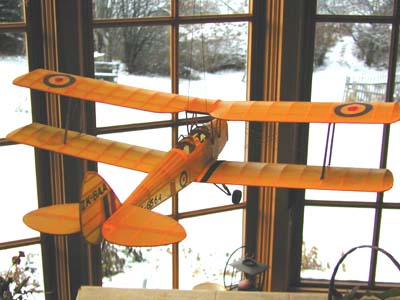 |
Flying High With Electric Power!
The Ampeer ON-LINE!
Fly the Future - Fly Electric! |
Site Table of Contents
| President: | Vice-President: | Secretary/Treasurer: |
| Ken Myers | Richard Utkan | Rick Sawicki |
| 5256 Wildcat | 240 Cabinet | 5089 Ledgewood Ct. W. |
| Croswell, MI 48422 | Milford, MI 48381 | Commerce Twp., MI 48382 |
| (810) 679-3238 | (248) 685-1705 | 248.685.7056 |
 | ||
| Board of Directors: | Board of Directors: | Ampeer Editor |
| David Stacer | Jack Lemon | Ken Myers |
| 16575 Brookland Blvd. | 8908 Sandy Ridge Dr. | 5256 Wildcat Rd. |
| Northville, MI 48167 | White Lake, MI 48386 | Croswell, MI 48422 |
| 248.924.2324 | 248.698.4683 | 810.679.3238 |
| Mailed Ampeer subscriptions are $10 a year US & Canada and $17 a year world wide. FREE on-line! | ||
| The Next Meeting: Date: Saturday, April 15 Time: 10:00 a.m. Place Midwest RC Society 5 Mi. Rd. Flying Field | ||
|
From Ken Myers The February 2006 Model Aviation had a couple of articles that I found "interesting". I gave the guys attending the February meeting a homework assignment. I asked them to read through the article "Fiberglassing the Wing Center-Section", p.41 - p.43 and then read "Plane Talk: Great Planes Matt Chapman CAP 580 46 ARF", p.66 - p.74, paying particular attention to what it says about the wing assembly of the CAP in the second column near the top of p.71. Never having put together an ARF, I was at a loss to explain why the wing on such an over-weight plane (my opinion) would be assembled in such a way. I still don't understand it.
Ampeer Reader Feedback Wanted There are a couple of topics that I would like to get some feedback from Ampeer readers about.
Feedback from last month's: Adding a Balance Connector to a Li-Poly Battery Pack
Great article on adding taps to packs! (Our thanks go to Jim Yuzwalk for providing that for us. KM)
I'm happy to hear of the winter fun this ship's (Air Hog Bipe KM) providing to so many "advanced" modelers! (Um, advanced? How? J KM)
Camille Thanks for expanding on the safety issues involved in adding the TP connector taps.
BATTLE CREEK BALSA BEES
Saturday, AUGUST 26th, 2006 Pilot's Fee $5.00 INCLUDES Hot Dog Lunch
Pilots briefing 9:00 a.m.
Spectators are welcome and entry to the field is free. The BALSA BEES flying site is located SOUTH OF I-94 EXIT 100 (Beadle Lake Road) approx. 5 1/2 miles to D Drive South, then WEST approx. 3/4 mile. Follow Beadle Lake Road past Beadle Lake, Harper Creek High School, Binder Park Zoo. WATCH FOR THE SIGNS!!! Cell phone help will be 269-275-9272. Cold soft drinks and water will be available. Contact Event Chair at 269-979-9272,
More on the "New" Charger Supplied With the EasyStar
I redid my review of the great electric trainer, the Multiplex EasyStar, in the February 2006 issue of the Ampeer and noted that it is now supplied with a much better charger. Dave sent me an email with more information about the "new" charger. KM I have the exact same charger that you picture as the supplied charger for the EasyStar RTF. Here is what I can tell you about it.
I've had mine for about four years and it still is working fine. I've abused it by charging 8 cell, 1700mAh NiCads most all the time, even though it's only recommended for up to seven cells. That is the charger that I got for my first electric; a Zagi 400X. I flew with three battery packs and that was my only charger for over two years. The only thing that has gone wrong with the charger is one of the three LEDs has quit working. The three LEDs are labeled power, tric, and quick. The power LED has quit working. It's not a big problem since as soon as you connect a battery, the tric LED comes on. It will trickle charge like that for as long as you leave it. You have to set the slide switch to your selected charge rate and push the start button to start the fast (quick LED) charge. It peak detects and drops back to trickle when it reaches full charge.
Thanks Dave. I talked with Keith Shaw recently and he had purchased the EasyStar RTF for his nephew. He told me that his nephew learned to fly the EasyStar very easily and that he has now recommended the Hitec Space Scooter for his nephew's second plane. This is an absolutely excellent way for anyone to get into this great hobby. KM Some "Real World" Li-Po Experience
Hi Ken: Just read the latest Ampeer (January 2006 issue KM) and the Li-Po thing was interesting and surprising to me.
Dick Corby Check out this site for some lab reports on Li-Po brands: www.trextuning.com/lipos.htm KM The Keith Shaw's Birthday Electric Fly
|
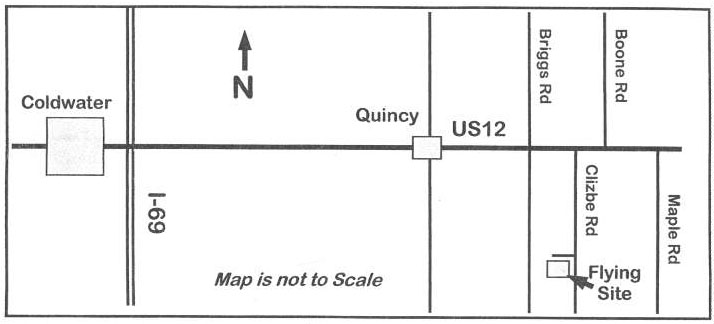
|
Dave Grife CD, 517-279-8445. Chispas Li-Po Beeper
Dear Ken, I have been very busy with my Horten flying wing with motor and new projects, a Projeti, F-27 Stryker and a Piper Cub Clipped Wing. Along with this my almost 4 years old 3000 NiMH batteries are dying on me and I had to face the choice of purchasing new 3700 NiMH cells or Li-Po packs.
Have good flights and smooth landings.
Circuit Diagram
If any of you build Chispas Li-Po Beeper, he'd love to hear from you. KM Student Flyers e-Book
I received the following email from Colin and I am passing on the information. KM I believe "The Complete Beginners Guide to Flying Radio Control IC Powered Model Aircraft" and "The Complete Beginners Guide to Flying Radio Control Electric Model Aircraft" are the first e-Books specifically written to help people wanting to learn to fly fixed wing, glow powered or electric model aircraft.
And "The Complete Beginners Guide to Flying Radio Control Electric Model Aircraft" Are priced at Ł4.99 each (approx US$9). Please visit our website www.rcfly.co.uk
Colin Bedson By Ken Myers This e-Book is the perfect introduction for the person who would like to enter the exciting hobby/sport of learning to fly fixed-wing, electrically powered R/C aircraft. Colin's easygoing, familiar style welcomes the beginner with the right amount of accurate information and without the intimidation of too many technical details. Part 1 includes sound advice about the essential considerations for the beginner:
More on the "Best Wire Bender"
Hi Ken, Got to agree with you that the bending tool you bought is the best ever. I have the same make and have been using it for at least the past 20 years. I lost the wing nut and original bolt, so I made a new bolt with nut as the clamp. I've attached an article I had published in the UK magazine Aviation Modeller International a while back based on an idea I came up with for bending identical items. Thought it might be of interest. (You can write to Tony and see if he might share it with you. In the US, you can get this bender from Hobby Lobby. They call it "Best Wire Bender". It is part number HLH704 and sells for $25.90. KM) |

|
Also, perhaps you can help me on something. I am building a Northrop XB35 flying wing powered by 4 X speed 400/480 motors and was wondering whether I can use 2 off Kontronics controllers running off the same battery pack and RX? Just trying to save having to buy a new bigger one.
Regards,
Thanks for your feedback on the bender Tony. I found your article very helpful! I don't have the answer to your question, so I am asking the Ampeer readers if they might be able to help you with your question? What do you think folks? KM Multipurpose Tiger Moth and More
I'm the guy from the western end of the U.P. (U.P. is what we call the upper peninsula of Michigan. We also call it "God's Country". KM) Here are some shots of my latest electric project, which is also my smallest. It's a Tern Aero Tiger Moth (the rubber FF kit from the '70's) that is about to take its first indoor test flight with the Plantraco equipment on board. It has a 17" Wingspan and AUW (all up weight) of 31 grams with a 7 mm Atomic SS pager motor and a 145mAh Li-Poly cell on board. 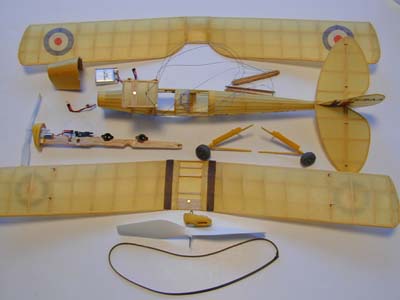 I have the motor, radio, and actuators on a stick that takes the place of the rubber motor (see photo). The linkages can pop off the actuators and be parked inside the fuselage and a rubber motor put back in with its nylon thrust-bearing nose. So it's "dual platform." If you are interested, I will send some better, completed photos and a flight report. Thanks,
And the follow-up: The Moth is still in evolution. I have had one successful, but marginal, flight at my local gym. The problem appears to be the Plantraco radio, in that even though they advertise that their ESC can handle 2 amps, it cannot handle the bigger 7 mm pager motor I used without browning out, even though it was drawing but 500-600mAh. I suspect that to make this system the 0.9-gram wonder that it is, they had to sacrifice a top-drawer voltage stabilizing system.
 The JMP Rx is being test flown in my Hangar Rat with different motor/gearbox/prop/battery combos and has been rock solid so far. As I am having a lot of fun flying my Hangar Rat, I won't make the switch to the Moth until I get the Plantraco equipment back from the factory and rule it in or rule it out for the Moth. I suspect the JMP will be transferred to the heavier Moth and the Plantraco will go on my Hangar Rat with a milder wind 7mm battery and a 4:1 box with at GWS 5x3 prop.
I'll attach some photos of the dual platform Tern Tiger Moth and of what I have dubbed the "R/C-3 Hangar Rat." Can you guess where the "C-3" comes from? :) TTYL,
Thanks Dick. Pretty interesting stuff. Ken the Troll. Low Cell Detect Circuit (LCDC) For Li-Poly Batteries
In the 02/06 and 03/06 Ampeer I described some of my frustrations with Li-Poly (lithium polymer) cells. I had spent big money on them and got little in return. In particular, I described how some costly 3.2 AH and 2.0 AH "high rate" packs were "not so good" from the start and then seemed to quickly get worse ("die on the shelf") thereafter. In contrast, I also described some other (brand) packs that were doing well at the start and ever since. (I bought more of these!)
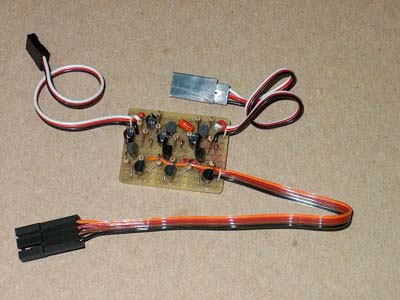 A photo shows a circuit assembly (LCDC) designed to do this task for a 3 cell Li-Po pack. This is a 0.6 oz assembly that I have exercised vigorously on the bench and also have flown. It is constructed with discrete ("thru-hole") components on some standard pc hole board. While it's not of the smallest possible circuit construction, it is very big on performance!
|
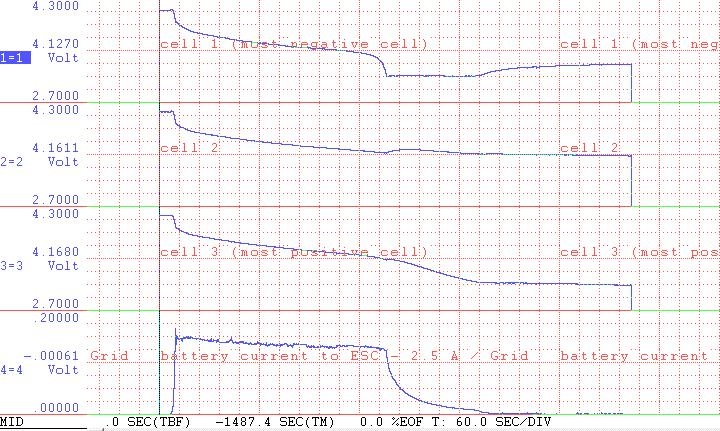
|
The top three curves are the cell voltages as recorded during the rundown of the fully charged pack. Partial throttle was set for a 15-amp initial current and then left in that (stick) position thereafter. This was intended to approximate the average in-flight current drain for this plane. The fourth (bottom) curve displays this current throughout the run. Its scale is 2.5 amps per grid.
Thanks again for you input Bob. It certainly appears that Fred Marks of FMAdirect.com is trying to do this with his BalancePro HD system that includes tapped cells, a Charge Protection Module and a Discharge Protection Module (DPM). While not exactly the principle as BobŐs LCDC, Fred's DPM prevents BalancePro HD battery packs from over discharging by monitoring individual cells in the pack, and providing a warning when voltage gets low. KM Upcoming April EFO Flying Meeting The April EFO meeting is the first flying meeting of the year. It will be at 10:00 a.m. on Saturday, April 15 at the Midwest RC Society 5 Mile Rd. flying field. The field is located on 5 Mile Rd. between Ridge Rd. and Naiper Rd. in Northville Township and is just west of the city of Plymouth, MI. You MUST have your 2006 AMA card. If you do not have it with you, you MAY NOT FLY. Sorry, but saying you have it won't do.
Drive Calculator 3.0 Beta 4 Released Christian Persson has released a beta version of Drive Calculator. It is now an application that runs on Windows or the Mac operating system. It is available at www.drivecalc.de. This is a Freeware program is for figuring out the possible performance of a chosen electric motor, gearbox, ESC, battery and prop combination. It appears to be reasonably accurate and is very easy to use.
|
To Reach Ken Myers, you can land mail to the address at the top of the page. My E-mail
address is:
KMyersEFO@mac.com
EFO WEBsite: http://members.aol.com/KMyersEFO/
